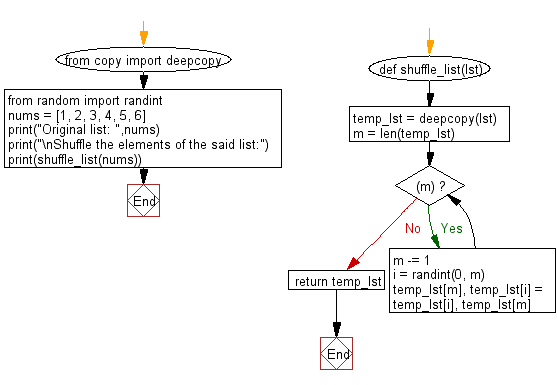Python: Randomize the order of the values of an list
Python List: Exercise - 221 with Solution
Write a Python program to randomize the order of the values of an list, returning a new list.
- Uses the Fisher-Yates algorithm to reorder the elements of the list.
- random.shuffle provides similar functionality to this snippet.
From Wikipedia,
The Fisher–Yates shuffle is an algorithm for generating a random permutation of a finite sequence—in plain terms, the algorithm shuffles the sequence. The algorithm effectively puts all the elements into a hat; it continually determines the next element by randomly drawing an element from the hat until no elements remain. The algorithm produces an unbiased permutation: every permutation is equally likely. The modern version of the algorithm is efficient: it takes time proportional to the number of items being shuffled and shuffles them in place.
Sample Solution:
Python Code:
from copy import deepcopy
from random import randint
def shuffle_list(lst):
temp_lst = deepcopy(lst)
m = len(temp_lst)
while (m):
m -= 1
i = randint(0, m)
temp_lst[m], temp_lst[i] = temp_lst[i], temp_lst[m]
return temp_lst
nums = [1, 2, 3, 4, 5, 6]
print("Original list: ",nums)
print("\nShuffle the elements of the said list:")
print(shuffle_list(nums))
Sample Output:
Original list: [1, 2, 3, 4, 5, 6] Shuffle the elements of the said list: [3, 2, 4, 1, 6, 5]
Flowchart:

Visualize Python code execution:
The following tool visualize what the computer is doing step-by-step as it executes the said program:
Python Code Editor:
Have another way to solve this solution? Contribute your code (and comments) through Disqus.
Previous: Write a Python program to map the values of a list to a dictionary using a function, where the key-value pairs consist of the original value as the key and the result of the function as the value.
Next: Write a Python program to get the difference between two given lists, after applying the provided function to each list element of both.
What is the difficulty level of this exercise?
Test your Programming skills with w3resource's quiz.
Python: Tips of the Day
Find current directory and file's directory:
To get the full path to the directory a Python file is contained in, write this in that file:
import os dir_path = os.path.dirname(os.path.realpath(__file__))
(Note that the incantation above won't work if you've already used os.chdir() to change your current working directory, since the value of the __file__ constant is relative to the current working directory and is not changed by an os.chdir() call.)
To get the current working directory use
import os cwd = os.getcwd()
Documentation references for the modules, constants and functions used above:
- The os and os.path modules.
- The __file__ constant
- os.path.realpath(path) (returns "the canonical path of the specified filename, eliminating any symbolic links encountered in the path")
- os.path.dirname(path) (returns "the directory name of pathname path")
- os.getcwd() (returns "a string representing the current working directory")
- os.chdir(path) ("change the current working directory to path")
Ref: https://bit.ly/3fy0R6m
- New Content published on w3resource:
- HTML-CSS Practical: Exercises, Practice, Solution
- Java Regular Expression: Exercises, Practice, Solution
- Scala Programming Exercises, Practice, Solution
- Python Itertools exercises
- Python Numpy exercises
- Python GeoPy Package exercises
- Python Pandas exercises
- Python nltk exercises
- Python BeautifulSoup exercises
- Form Template
- Composer - PHP Package Manager
- PHPUnit - PHP Testing
- Laravel - PHP Framework
- Angular - JavaScript Framework
- Vue - JavaScript Framework
- Jest - JavaScript Testing Framework
